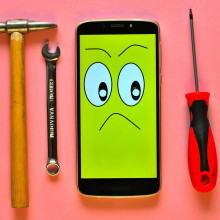The Right to Repair: Get your fix
Whatever happened to make do and mend? Many of us, it seems, have lost the ability to fix the things we buy. So are manufacturers on a mission to make things impossible to fix, forcing us to buy new ones? Or should we be taking more personal responsibility to reduce waste?
In this episode

01:60 - Trying to fix broken gadgets
Trying to fix broken gadgets
John Naughton, University of Cambridge
Have you ever tried to fix a piece of technology that you own and come unstuck? Well that’s what happened to John Naughton, a senior research fellow at the Centre for Research in the Arts, Social Sciences and Humanities at the University of Cambridge. He set me off on this investigation into the Right to Repair when I paid him a visit…
John - Well, my most precious object, precious electronic object anyway, was given to me by a dear friend. But after a while it gave up the ghost: battery went, the hard drive failed and it was hard to get into. That was the real problem. How did we open it up so we can get at it? It had cunningly designed screws for which nobody, no normal person, has a screwdriver. Now you could not bring that to a store. In fact, if you tried to, they'd say, well, that's an interesting antique, now would you like to put it in the bin?
James - There's an environmental cost to all this as well, isn't there?
John - There is because given that these devices have actually quite long lives if you ignore the fashion side of it, the model of making consumers or persuading consumers that they really want the next one raises a question, which is what happens to the old one? And they're getting discarded. So where are they going? They're going to mountains of e-waste. They're not really being effectively recycled. And it's unnecessary waste in some respects because if this stuff works for 20 years, why don't we keep it for 20 years?
James - So what do we do about it? Is this something that the government can intervene in?
John - It's something that only governments can intervene in, really, because the only way of making this better, I think, is to have legal restraints because the one thing you can, in general, hope for is that corporations obey the law. They don't do much else, but they do obey the law in general. Partly because they're worried about the legal consequences. So you need legislation. And one of the things that we have needed for a long time is a legal right to repair devices. Because, at the moment, in many cases, the corporations who make the modern kinds of devices that we now have come to rely on, they have been very determined in opposing any kind of legal requirement in this respect. And they will use, they do use, a whole range of techniques for making the right to repair difficult to implement. For example, they make their devices very difficult to open.
James - As you found out.
John - As I found out. What you'd need to open a device requires the kind of screwdriver you have never heard of. As we speak, you're looking at the iFixit toolkit that I've got that has screwdriver heads that you've never seen before. Right?
James - I can attest to that.
John - And so that's one technique. And also then they use the law. For example, this is true for most of these manufacturers. Somewhere in your device there's a thing which says no user serviceable parts. If you ignore that, then you void your warranty and you lose your rights in all kinds of ways. Corporations have been resisting the right to repair. Slowly we're making some headway. I think it's about feeling that our rights are being taken for granted. Because in a lot of cases we buy these things, we think we own them, but actually we can't do anything with them that hasn't been approved by the manufacturer. That's not acceptable. There are cases, there are good arguments sometimes why we shouldn't be allowed to tamper with stuff. Many cars are like that now. And for example, I have a Tesla, it would be really very, very dodgy if I started to think I could fiddle with it. And so there is a case for there not being a right to repair, but it ought not to be a general thing. It ought to be specifically for where this is actually dangerous.

06:02 - Why are appliances so difficult to repair?
Why are appliances so difficult to repair?
Tim Cooper, Nottingham Trent University
The planet is the real loser in our replacement over repair culture. So how did we get to this point? With us now is Tim Cooper, Emeritus Professor of Sustainable Design and Consumption at Nottingham Trent University.
Tim - I think there's a systemic problem. I think we're in a consumer based society where there's a benefit, commercial benefit, to companies, making products that are worn out, whether it's how they look or how they work or how long they work. For most businesses, gradually reducing the lifespan of products over a sustained period of decades, they make more money that way. There are, of course, a few products that last much longer, a few companies that are focused in that area, but it's a relatively small share of the market, but they demonstrate that it is possible to make longer lasting products.
James - So are the manufacturers doing this on purpose? Is that what you're suggesting? Is it right to lay the blame on them?
Tim - No, I'm not suggesting that at all. I'm saying it's a systemic problem and I think governments, companies, consumers are all to blame. We all have a role to play. As John said just now, governments have got a role in setting the framework, the legislative framework, that determines whether products are allowed to be put on the market - short-lived products, irreparable products. Consumers have got a role because if there isn't a demand for products that are repairable, then it's pointless to introduce legislation or for companies to do research making them repairable. You can make a repairable product, but they're still thrown away when they break because the consumer can't be bothered to get it repaired. It's too expensive to get it repaired. So we all have a role to play in this.
James - Let's take those points in turn and start with, as John was alluding to, the fact that the technology companies are starting to take this a bit more seriously. Is that because of legislative pressure they've come under?
Tim - Yes. Over the past 10 to 15 years, there's been the growth of what's being called the circular economy debate. And in particular, this has been strong in Europe. Legislation is gradually being introduced to force manufacturers to address the problems of short-lived irreparable products. Companies need time to adapt to that. The concern is how much time we've got and, certainly as John was alluding to earlier, too many companies are trying to slow down the process, but the process is inevitable because we all know that the whole world can't live in the way that rich industrialised countries have been doing in recent years. We all have to move onto a more sustainable path where there's far less waste, where products last longer and at the end of life they're fully recyclable.
James:
In practical terms, what's being done to make repairing electronics simpler?
Tim - Well, a number of things are happening. In terms of the requirements, over time we are going to see products labelled with their repairability and with their durability. Already that's happened in France. They brought in legislation before the European Union. That came into force three or four years ago now, where a small number of products now, when you buy them, there's a label that says how repairable they are. The European Union is moving in that direction, and those labels will be ready probably by around 2025 on a limited number of products. And as they do this, consumers will be able to make informed judgement as to whether or not they want to buy a product. And I think we'll see the same kind of trend as we did with energy labels, that people will say, well, why would I buy a product that's designed not to be repaired when there's one that could be repaired? That's only part of the problem as I just said a moment ago. We still need to have the question of how expensive it is to repair products rather than replace them and we still need that desire to keep things going for longer, which means we have to have products that are designed for upgradeability, particularly in the high tech sector.
James - I'm pleased to hear your optimism when it comes to consumers and their approach to buying products that they know will be more sustainable, even if it might hit them in the pocket. How have you come to that confidence?
Tim - Well, maybe that was slightly misleading if I was optimistic. What I was trying to say was that consumers need to play their part, and there is evidence that if products are longer lasting but better value for money, then they will move in that direction. Consumers are often irrational, but they're often very rational indeed. And if they see products on the market and one is cheaper than another and there's no real assurance that the one of a particular brand or a particular functionality will last long, they won't pay the extra. So we do need to have communication with consumers to put them on the right track. We also need to raise people's expectations. I think people, in my generation, we were used to products being designed to last for as long as possible. It's only really in recent decades that we've moved to a society where people do treat electrical goods as throwaway items. And then the legislation actually isn't very strong on that at the moment. So these new laws, right to repair legislation, for example, the revisions to the Ecodesign Directive, they actually tend to focus on the large products. One of my concerns and one of my frustrations are small appliances, which are proliferating in the industrialised countries, and those products are often very short-lived.

11:53 - Repair cafes provide a way to get your fix
Repair cafes provide a way to get your fix
Now one prong of the Right to Repair movement’s plan to reduce waste of all kinds is to help people directly with fixing their things at community events known as Repair Cafes. The idea is that you bring your broken item, electrical or not, and volunteers see what they can do to try and help you out with it. I went to one such event in Dagenham this week, and there to talk me through how it all works was Michaela Main from the East London Waste Authority...
Michaela - We've got electrical fixers from Restart: brilliant organisation. We also have Kemi delivering us some textile repairs. We have some bike repairs and MOTs. We sort of say to people, come along and we'll try our best. We can't guarantee a fix, but maybe the electrical repairers can diagnose a problem at least and suggest a spare part that somebody could get and that's on the right track to the repair. Some people might want to bring large items. We did have a request for someone to bring a lawn mower today, but I actually did put them off and I did signpost them to Restart because there's lots of forums, lots of people having discussions. So it's a little bit like we might limit to smaller electricals just because we want to make it a bit more accessible to people.
James - Just as I was setting up, I was amazed at how simple it was. There was a gent who brought in a coffee machine and literally just came up to you at the desk and said, "hi, my coffee machine's leaking." And within a second he was pointed to someone who was willing to help him try and fix it.
Michaela - What you saw with Quentin coming in today with his coffee machine, luckily someone was ready to take his repair. Otherwise, sometimes, it can be a little bit of a wait. But what we've got, we've got some refreshments, we've got people to chat to, we've got some information on the tables. So we want to create an environment where if you do have to wait a little while, that's okay, but you will be seen.
Kemi - Well, I just finished helping somebody extend the life cycle of her duvet cover because the poppers had gone. So fortunately for me, I come with everything, my bag full of tricks and all sorts of weird and wonderful things inside my bag. So I had these little plastic poppers and I said to the lady, "well, we can't really use your ones because they're gone, but I've got some poppers." So she was like, "really?" So I've shown it to her and she said, "how are you going to do this?" I said, "well just watch and see what happens." Well, we finished it and I've repaired her duvet for her.
James - What is it that motivated you to give your time and your expertise?
Kemi - I get motivated because it's always been my passion, reducing waste and repurposing lives [of garments]. And what I've discovered is it's a skill that we're losing. Fast fashion is a big problem. There's too much, it causes too many problems - carbon emissions. If people can't repair it, they throw it away. You can extend the life cycle of a garment. and it just slows you down from buying too much. You know, we need to take our planet more serious. I'm a person who's very much passionate about our environment.
Stefania Yes. My name is Stefania and I'm a volunteer for the Restart project.
James - Before I interrupted you, what is it that you were doing?
Stefania - I was tidying up after a failed repairing that was a steam iron that for some reason wasn't working. We tried to open it and I gave up. Sometimes it's not easy. We took a lot of time to open it because there were two different safety screws and that is the main issue for us: to get inside the items. We found 50 different screws in all the items that we repaired. In practice, are you supposed to have 50 different screwdrivers? That is crazy.
James - You've just sort of started this afternoon slot and there's already a bit of a busyness about the place.
Michaela - So we had a gentleman called Joe come in this afternoon just before we'd opened, and he said, "I saw a poster but there wasn't a telephone number to call. I don't go online." So it's having the right advertising, but also what we actually want to encourage and we want to see is community groups setting up themselves. That's much more sustainable. Eventually, funding runs out, funding always runs out. But if we've got community groups that we can support then we can keep it going that little bit longer.
James - Is there a lack of confidence that you see with people who bring their things? Relatively simple fixes that people are not confident enough to do themselves? So as much about fixing things, it's about showing people that it can be done?
Michaela - Yeah, absolutely. And as part of the repair cafes, what we try to encourage, and you can see it here today, is the visitor is sitting with the repairer. So not only are they having their item fixed, they're hopefully learning what's happening. So they're seeing their item being opened up and this afternoon we'll have a children's workshop as well. So they'll be learning how to use a screwdriver and how to unscrew something. The other thing is that lots of us will say that items are made to be thrown away to buy the new one. And actually, that is very true, but also that's the easy way out. I think that sort of makes people feel a little bit less guilty.

17:51 - Fixing mixers shows how to rethink repairing
Fixing mixers shows how to rethink repairing
Diana O'Carroll
Time to hear from another passionate repairer now: writer, designer, and ex Naked Scientist Diana O’Carroll. Over the past few years, she’s been dedicating lots of her time to repairing old Kenwood machines. For the uninitiated, Kenwood is a manufacturer of domestic appliances, best known for food mixers. I spoke to Diana to find out more about her hobby repairing machines over half a century old…
Diana - I do have some modern things. I have the iPhone and a little robot vacuum cleaner, but I also have Kenwood machines and mixers from the 50s and 70s and I enjoy fixing them and taking them apart and stripping them right back to their components and then putting them all back together again.
James - If you don't mind me asking, why?
Diana - Well, it started off just as a challenge really. It was like doing a jigsaw puzzle, but at the end, instead of getting a pretty picture, you got something that actually worked and that you could use. And while I was doing this, I just learned so much about how the quality of the components can affect, what you end up with, how long something lasts. I realised how easy it was to repair these older machines.
James - It started out as sort of a point of intrigue and then by the very nature of the fact that you could do it in contrast to modern tech, it became liberating almost.
Diana - We have technology that's just sitting around, very cheaply available and can still do a really, really good job. Kenwood were essentially early pioneers of sustainability, I think it is fair to say that, and you don't really need to be an expert. I mean, obviously, when you're dealing with the circuitry, you probably should have some training and take certain precautions.
James - Is it a case of, that's possible with that more primitive technology, but when it comes to the phones we use or the laptops we use, that's got a level of complexity that needs some expertise?
Diana - There is an element of that. And if I'm talking about stripping something right back to the individual screws and capacitors or whatever, then yes, obviously the more primitive a technology is, the easier, the more accessible that's going to be. However, I have fixed things like my robot vacuum cleaner, for example, which has really very advanced stuff. It's essentially got a bit of AI. It has lidar to navigate its way around my house, but that was built in a modular way, which meant I could take it apart very easily and then I could replace the individual bits which internally would've been quite complex. But you can just buy these parts, quite cheaply. So for example, the bit that I needed to replace was a little motor, which spun the lidar sensor around in the top because that had worn out. And it cost me about 10 pounds. I just replaced it. It took me 10 minutes and it was working again. And that was because the company had made it easier for me to do because of the way they'd built this machine.
James - Does it anger you, if I was to take it that far, to think that you could take a piece of technology that's a couple of years older and you might ask them to fix it for you and they essentially tell you where to go.
Diana - I have been frustrated in the past. There was one item that I knew was a really easy repair for the company to do. It wasn't something that I could do because I didn't have the right machines to do it, but I knew for a manufacturer they could do that really easily, really cheaply. It would mean that no more components would have to be used and the item could continue being used. It wouldn't have to go to landfill. But they didn't want to do that. They didn't want to fix it. It would cost them too much. It would erode into their their profit margins. So the item got thrown away and that was that: a total waste. What also frustrates me is that there is a cynical attitude towards the customer. I think there is an element with some companies where a customer is just a cash cow. They're there just to buy the product and spend lots of money, as much money as possible. And it's no longer about creating a product, which is not only nice to use, not only useful, but good quality and will last and can be kept working for many years.

22:21 - Planned obsolescence playing a part in waste?
Planned obsolescence playing a part in waste?
Tim Cooper, Nottingham Trent University & John Naughton, University of Cambridge
Tim Cooper is still with us.
Tim - It's a problem because it actually slows down the repair process. Time is money. The longer it takes a repairer to open the bit of kit...
James - My question was more why it's been allowed to be this way that it's so hard to get into these items.
Tim - I think it's to do with a degree of complacency and what's been called the desire for the new., It's the fact that consumers are very happy to replace things because sometimes we actually would quite like something that's new and fresh and shiny and has the latest features. And if it's developed a fault, then not being able to get it repaired or finding it a little bit too expensive to get it repaired is a good excuse for buying something that you really would like to have instead of the old thing.
James - And so let's get into it a bit more of a discussion from earlier. What are some of the main ways that you see out of this throwaway culture we have and moving now towards a more circular economy model?
Tim - Well, I've already mentioned the couple, which is to improve labelling of products so consumers know what they're getting. We know about energy efficiency. We also need to know how long have products been designed to last? Are they designed to last 5 years, 10 years, 15 years? I think there are other policies that are needed as well. We look at the cost issue. Many consumers buy new because the cost of the repair is as expensive, even more expensive than the cost of replacing the item. That can be helped to a degree by changing legislation by, for example, getting rid of VAT on repair work, which has already been done in several European countries. Sweden, for example, reduced their VAT rates several years ago. Czech Republic, others have certainly considered that Britain now has a degree of freedom because of course we're not in the European Union. So that was often an excuse. So one thing is to change the economics to make it more likely. Another way forward is to look at guarantees. Now most people when they buy a product, they're wanting something often which is functional. They don't buy a washing machine because they want a square block of metal with a drum that goes round and round. They want clean clothes. So why not move towards society where you are buying that service, where there's a guarantee that that product will last and put the onus on the manufacturer to design it in a way that if it breaks, they have to pay for it. We need to move towards a society where expectations have grown. In small appliances, nothing will last less than five years. For large appliances, nothing last long, less than 10 years, and ideally a lot longer than that.
James - I'd like to play this clip out now. It's another excerpt from my chat with John Naughton. It relates to the idea that we haven't touched on so far, but was related to all this, which is planned obsolescence have a listen:
John - Planned obsolescence is actually a very old idea, and it goes back at least as far as the early days of the automobile because in the United States, in the 1920s, Henry Ford invented a way of making cars. He invented a production line system, established a way of doing things, which has lasted for a century. Ford was a very utilitarian man. He believed he should produce cars that ordinary Americans could use. He famously said, you can have any colour of a Model T Ford that you want so long as it's black. And then along come other car manufacturers, most particularly what became General Motors, led by a man called Alfred Sloan. And his great idea was that we should harness some of the weaknesses of human nature, which is that for some reason, hard to explain, we are all always trying to keep up with the Jones'. And he came up with this idea that you design each model for a particular life, and the effective life could be a year, even though they could go for over 20 years. What you do is you introduce cosmetic changes from year to year so that people who bought last year's model, they suddenly get worried when their neighbour has this year's model, which has got different fins or it's got different chrome or it's got some different kind of cosmetic changes. And that proved to be very successful. And it came to be known as planned obsolescence where you designed something to have a fixed life.
James - So planned obsolescence, as I was saying, it's a related but importantly distinct idea to making the right to repair difficult. Does planned obsolescence also have a part to play in modern e-waste?
Tim - Yes, it does. I think that this is quite a complex issue because the point about planned obsolescence is that it's an intention, it's a decision to curtail the lifespan of something shorter than which it could be designed to last. So in other words, they're saying, well, we could make it last 15 years, but we're going to make it last 10 years. Although it's far better environmentally to design products that last longer, that will affect the cost and the price to consumers. And many people would counter the argument for increased longevity and increased repairability by saying, well, actually we need cheaper products so poorer people can afford them. And I think that's a very soundly made argument. And it just highlights the fact that the issue is complex and governments have to address issues of social justice alongside environmental issues because to make a throwaway society where stuff is cheap, that has to be solved, and if it means having to increase the affluency of poorer people so that they can afford what are essentials of life these days, certainly for things like washing machines and the like, then the government should look at what it's doing in terms of the growth between the rich and poor, and address that as well as addressing the environmental issues.
Related Content
- Previous Can we control AI?
- Next Turning the other cheek










Comments
Add a comment